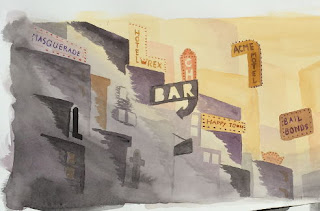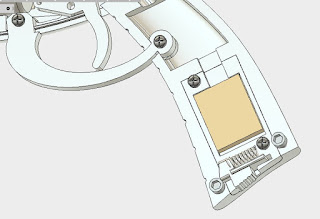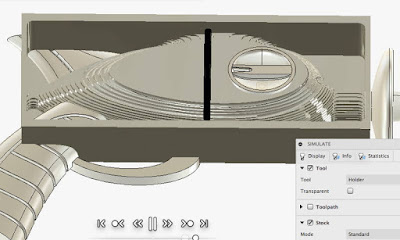Reality too often is when I'm up against a deadline, shows to be built without enough time or material in places with difficult access...I'm also more often than not, it feels like, at the end of my financial rope.
I'm there right now. Painting all day out in the hot sun is physically challenging, trying to work fast enough for the opening night deadline yet neat enough is mentally challenging, as well as physically challenging in its own way; I'm struggling just to keep the tremors down from near-heat exhaustion, yet having to make extremely precise moves with an unfamiliar brush.
But, of course, I'm doing this hungry -- can't even afford lunch anymore, and there's not enough gas in the tank to get me to work through the end of the week, either.
This was among the tasks for today (well, actually -- we ended up doing the stairs differently. This was me working in Carrara to see if I could problem-solve how to translate the desired pattern on to the surface of a flight of stairs. The ones I did today were done with ruler, and once again I felt like I was trying to trisect the circle or something as I worked out the geometry.)
(And, yes. It's one of the two well-known musicals that requires swastikas. Makes you wonder if there are musicals that require, say, the Japanese W.W.II "Meatball." Well...if you want dangerous symbols, I know of one musical that might require the Elder Sign...)
The Shapeways order arrived, at least. The parts all look plausible, and I am really happy now that even if I do go on to make a metal one some time in the far future, I will have been able to problem-solve the CAD files on a simpler 3d print instead.
The parts I printed at TechShop don't fit quite so well. I need to re-print the donuts, probably. Which is a pity; I did a nice job of smoothing them out -- chucked them in my drill press and held sandpaper up to them.
And of course I still need several other parts, both printed and (preferably) milled. Which is basically going to have to wait until next week. About the only things I can really do this week is sand smooth the print and prime it, as well as install the electronics (and get started on programming.)
Among other compromises to meet deadline, I'm skipping trying to make the Atomic Energy Cell work properly. As of the moment, it will have to be pried out, and the connector to the Lithium Polymer battery fished out of an inconveniently small hole in order to recharge the thing. Well, it beats the Morrow Project CBR -- a failure in the lid latch meant I had to glue the box shut around the batteries!
Also for next week is any plan to run off this thing:
Yes: it's the Acme Disintegrating Pistol. And yes; in the original cartoon Duck Dodgers holds it with one finger inside the trigger guard, as shown here. I am somewhat tempted to just fire up my scroll saw and knock this thing out this week out of 1/4" MDF, but some parts are so thin I am afraid it might actually disintegrate (like its namesake, if not quite as completely) unless I make it from better wood or something like acrylic.
And besides -- as much as I want to turn this thing in to the client on the same due date as the Raygun, the latter must take priority in my efforts. At least once this week is over I will be a little bit freer of immediate financial worries.
If I can somehow stretch one day of gas and two days of food to cover from Wednesday through till Friday....












